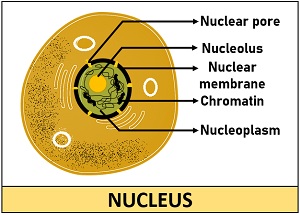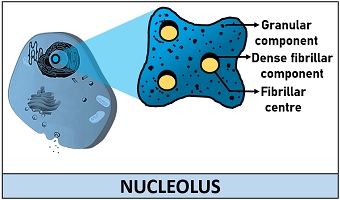The difference between nucleus and nucleolus is mainly due to the following factors:
Location: Nucleus is the core central organelle of the eukaryotic cell, while nucleolus resides interior to the nucleus.
Size: The size of the nucleolus is very small compared with the size of the nucleus.
Under the microscope, the nucleus appears as a dark spot, and nucleolus appears as a darkly stained region within the nucleus. Both are important for the multicelled organisms, which maintains the integrity of the cell by regulating specific genes for the cells to function correctly.
Content: Nucleus Vs Nucleolus
Comparison Chart
| Properties | Nucleus | Nucleolus |
|---|---|---|
| Meaning | The nucleus is the most crucial compartment of the cell enclosed by the phospholipid bilayer nuclear membrane, which outlines the nucleolus and the other contents within the nuclear sap | The nucleolus appears as the small region that lies internal to the cell nucleus, which plays an essential role in the biogenesis of ribosome and protein synthesis |
| Location | It is located centrally within the eukaryotic cell, i.e. cell cytoplasm | It reside interior to the cell nucleus, i.e. in the nucleoplasm |
| Structure | Its structure include a surrounding nuclear membrane, dense nucleolus and nuclear matrix | Its structure generally include a fibrillar centre, granular and dense fibrillar component |
| Size | Its size is largest among the other cell organelle found in the cell cytoplasm | It is smaller relative to the size of the nucleus |
| Diameter | Its diameter ranges 1-10 µm | Its diameter ranges 0.2-3.5 micron |
| Shape | Oblong | Nearly spherical |
| Formation | It forms by the infolding of the cytoplasmic membrane | It originates through the nucleolar organizing regions of the chromosome |
| Membrane boundary | A phospholipid bilayer nuclear membrane encircles the nucleus | There is no such membrane boundation |
| Chromosomal content | It stores the chromosomal content | It lacks chromosomes |
| Rich in | The nucleus is the region rich in DNA | The nucleolus is the region rich in proteins and RNA |
| Cell constitution | It accounts for 10% of the cell’s volume | It accounts for 25% of the nucleus volume |
| Function | The nucleus directs various genes to function and perform various tasks for the cell growth and metabolism | The nucleolus equally plays a crucial role in the biosynthesis of ribosomes required at the time of gene translation |
Definition of Nucleus
A nucleus can define as the most crucial cell organelle of a eukaryotic cell, which regulates the genes of the DNA to perform different tasks including cell metabolism, growth and reproduction etc. It is the storehouse of hereditary material, which contains the considerable genomic content condensed into the various forms like chromatin or chromosomes during the cell cycle.
The nucleus appears as a small sphere within a cell, which is encircled by a selective nuclear membrane that functions as a barricade for the passage of macromolecules. Nucleolus and the chromatin dispersed inside the nucleoplasm or nuclear sap are the components, which are interior to the nucleus.

Besides, some nuclear pores are also found on the nuclear membrane, which allows the free exchange of small ions and protein-mediated translocation of macromolecules within the cell and nuclear matrix.
Definition of Nucleolus
Nucleolus can define as the sub-organelle found within the nucleus, which performs a central role in mediating the biosynthesis of ribosomes. Its ultrastructure encompass the fibrillar, granular, dense fibrillar components. The fibrillar centre is the site for the formation of ribosomal proteins, in which rRNA binds to the specific protein precursors.
Granular components carry rRNA that binds to ribosomal proteins and acts as a site for pre-ribosome assembly. The dense fibrillar region allows the processing or some modifications in the newly transcribed rRNA connected to the ribosomal proteins.

In the plant cells, nucleolar vacuoles are also present, which lacks an animal cell. It constitutes 25% of the cell nucleus. The quantity of nucleoli differ among different species of plant and animal cells. It is also known as “Ribosome factory” that aids the production of ribosome subunits and protein synthesis.
Key Differences Between Nucleus and Nucleolus
- A nucleus can define as the membrane-bound organelle, which resides within the cytoplasm of the eukaryotic cells. In contrast, the nucleolus is the sub-organelle found inside the nuclear matrix and lacks a membrane around it.
- The nucleolus is sometimes located near to the nuclear membrane or sometimes at the centre of the nucleus. A Nucleus generally resides centrally in the majority of the eukaryotic cells.
- A size of the nucleus is the largest among the other cell organelles found in the eukaryotic cell, and its diameter ranges 1 µm (in yeast cells) to 10 µm. Oppositely, a size of the nucleolus is smaller than the nucleus, and its diameter varies between 0.2 to 3.5 micron.
- The ultrastructure of nucleus possesses several nuclear pores over the selective bilayer nuclear membrane, dense nucleolus and viscous nucleoplasm. Granular, fibrillar and dense fibrillar regions are commonly found in the ultrastructure of the nucleolus, and an additional component (nucleolar vacuole) can also be seen in the plant cells.
- The origination or existence of nucleus and nucleolus is also an essential factor, which we must know. It is believed that the structure of nucleus forms by the several infoldings of the plasma membrane, whereas nucleolus forms by the nucleolar organizing regions found in the chromosomes.
- The nucleus contains the chromatin or chromosomes that are dispersed throughout the nucleoplasm, while nucleolus lacks such structures.
- The nucleolus is rich in RNA and proteins and constitutes about 25% of the nucleus volume, while the nucleus contains a high amount of DNA and holds 10% of the cell’s volume.
- The primary function played by the nucleus and nucleolus is that the former stores the genetic content and controls all the cell activities, while the latter acts as a hub of ribosome biogenesis.
Conclusion
Therefore, we can conclude that both the nucleus and nucleolus carries out a significant role in the cells of multicellular organisms. Both are the basophilic bodies, which take up the colour of basic stain due to the presence of negatively charged bodies like DNA, RNA, and histone proteins. The ultrastructure of nucleolus as well as the nucleus can be observed through the electron microscopy.
This helps me a lot in completing my science project. Thank you so much!